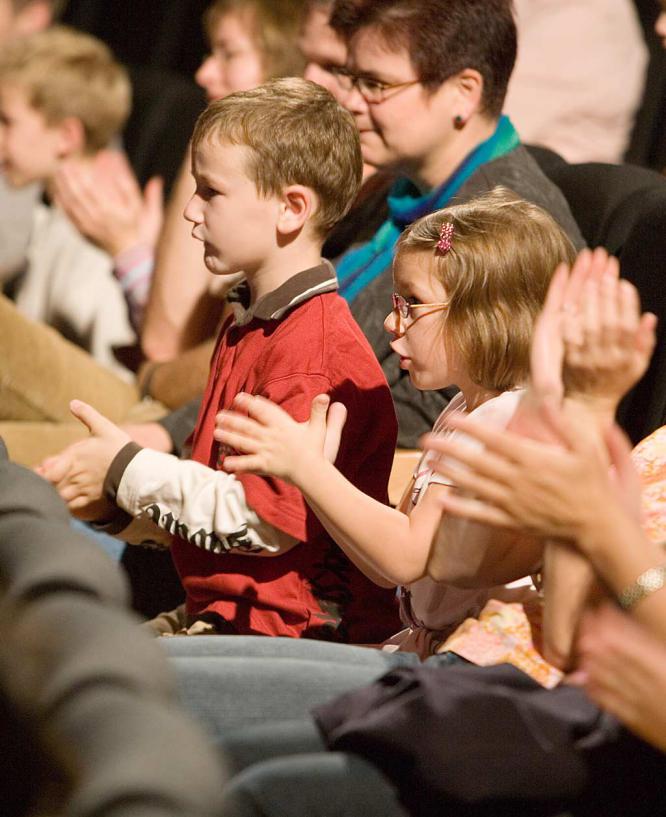Zweier Circus
«Circus-Poetry without Words
Olga and Pierino at the Shakespeare Company, Theater am Leibnizplatz, (Theater at the Leibniz square), Bremen.
Oversized balloons glide weightlessly through the theater: red, orange, and white. As by magic, the gently floating giants produce happy smiles on the faces of those in the audience. Arms are reaching up, everybody would like to catch a small piece of this limitless lightness of being; even if it is only for a split second.
People who go and watch Olga’s and Pierino’s “Zweier Circus” are changed. For two hours they immerse themselves in a magical world of circus poetry, offering us, without words, a wonderful feeling of being detached from this earth. With ballerina and clown we may be children again or, at least, dream about childhood and forget about all the stress and sensory overload. Pierino teaches both children and adults the great art of deceleration and the brilliant smile with which he does it, is simply contagious.
Irma Paulis, well-known in Bremen, has weaved together the varied talents of the artistic couple who live in Munich, and has created a quiet, complete work of pantomime, acrobatics, dance, dressage, and juggling. Jacob Ter Veldhuis has set it to a musical background of tango and tap rhythms, Russian and oriental folk tunes, and a good helping of carousel music. Olga and Pierino delight with their merry-go-round of the heart, rich in fantasy and colors, and the audience feels inspired and uplifted.
They transport us to a world of singing, rainbow-colored tops in which a goose, climbing out of a star-covered surprise egg, dances the waltz, and two tiny dogs enthusiastically copy her. Pierino tries to capture the heart of Olga the ballerina with all sorts of clever tricks, he pulls out all stops as a musical clown – even turns into a living accordion. There is a brightly polished trumpet, double the size of an alphorn, and a tiny 1/16 size violin to marvel at. Finally, Pierino’s chagrin d’amour is answered by the bell fairy Olga, they find each other for the last pas de deux and have oversized marionettes dance the tango.
They are always looking for the audience to make a creative contribution which generates communication. For instance, the poetic couple, fitted out by Inge Steineke with gorgeous, enchanting costumes, directs them to intonate a veritable ship’s siren symphony. Colorful fantasy-instruments are distributed among the audience for this purpose, while the conductor-duo brings to life the foghorn-sound with hands and feet. Enthusiastic applause for the well-attended, double guest performance of Zweier Circus by the Bremer Shakespeare Company.»
Weser-Kurier and Bremer Nachrichten (newspapers), 20. June 2005, Sigrid Schuer
Circus
«Apart from everything else, there is one discovery to be made in their program (Circus Nock, Switzerland): The circus has a new clown. His name is Pierino, he has unmistakably been trained at the Dimitri School, however, this does not mean in any way that he does not have his very own, unique character. His reprises are not just mere fillers during set changes, they are small, kindly crafted vignettes with quiet, subtle humor. He performs with hardly any make-up on at all, wearing a red pointy hat, he swings the diabolo, wrestles gently with the deviousness of the objects, and rushes, almost shyly, behind the curtain as soon as the applause can be heard. During his entrance he dazzles with musical and acrobatic skills and makes the plates dance on their poles as though he were Chinese. A new clown with a feeling for nuances, with this type of charisma, is not an everyday occurrence in the world of circus.»
Neue Zürcher Zeitung (newspaper), 23.-24. August 1980
«The incredibly good clown ‘Pierino’ guides us though the circus scene in this year’s program – just on his own he would be worth the entry fee, because his affectionate, compassionate face, his clean gestures, his sensitivity in sensing everything about audience and circus, are an inspiration to anybody. He was a student at the Dimitri School in Ticino and it seems that he means to out-do his master, because ‘Pierino’ – the former school teacher – might have descended directly from the artists’ heaven.»
Vaterland, 18. September 1980
«For the third time already, comedy artists from estrade, cabaret and circus are converging under Circus Slovan’s big top to pit their skills against each other. In the first year, the trophy was won by Leonid Jengibarov – a clown of world reputation with an expansive art form, who is a trailblazer of the modern art of clowning. Of all the participants at the premiere this year, the Swiss guest clown Pierino, a student of the Dimitri School, came closest to this great example and his innovative artistic values. His lyrical passages, his masterful art of juggling, and his musical professionalism are completed subordinated to clown plot and comic effect.»
Rude Pravo, Prague, 23. November 1981
«But then an artist steps on the stage, the likes of which have never been seen before in this house: Pierino. In the end, after a late, second performance, he uses his last act to bring everything to a meaningful conclusion. Pierino is a modern harlequin, pantomime clown, acrobat, and musician. This places him clearly outside of the commonplace-type clowns one usually encounters. He performs idiosyncratic little vignettes, loves especially the quite tones, the fine, well-thought-out humor, and the precise, detailed accuracy and special subtleties. Although he is only presenting part of his great repertoire at the Hansa Theater, he is the audience’s favorite from the start; one understands him, and enjoys loving heartily at his tricks and gags, which are by no means easy. Pierino sets new standards and is an asset for the program.»
Hamburger Umschau (newspaper), December 1981
